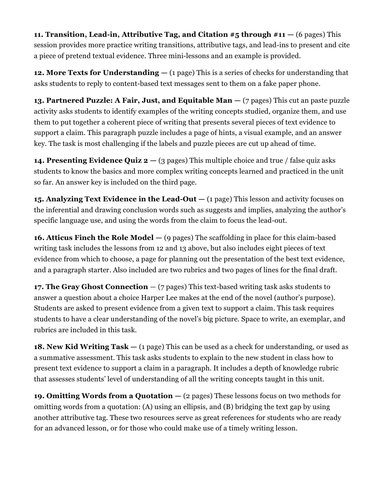






























This in-depth writing package provides teachers with what’s needed to teach students how to select, present, and analyze text evidence to support a claim in writing. This 80-page unit uses the text of Harper Lee’s To Kill a Mockingbird to teach and reinforce those lessons.
In addition to lesson and practice materials to reinforce the necessary writing concepts, this package also includes well-guided novel-based writing tasks, rubrics, exemplars, drills to reinforce, checks for understanding, and quizzes.
While the terminology used to teach students how to select, present, and analyze textual evidence is not complex, some of the writing concepts will be new to students. This package scaffolds the process to allow students the opportunity to
- study the writing concepts,
- identify the writing concepts in other people’s writing,
- analyze how those writing concepts function,
- practice applying the concepts in guided workouts,
- apply those concepts in their own writing,
- identify the concepts in their own writing,
- analyze the effectiveness of those concepts in their own writing.
In addition to common terms such as topic and concluding sentence, the ‘Super Six’ terms below are the main concepts upon which this writing unit is based:
TRANSITION — A word or phrase used to connect one idea to the next.
LEAD IN — Gives context or background information to the text evidence. When are we? Where are we? In brief, what’s been happening plot-wise leading up to this text evidence?
ATTRIBUTIVE TAG — Whose words were borrowed? Are those words best described as narration, thinking, or dialogue?
TEXT EVIDENCE — Purposefully selected because something about it makes it some of the best evidence to support a(n) thesis, claim, argument, stance, statement, or answer.
CITATION — MLA in-text citation (Author 283).
LEAD OUT — It’s analysis. It answers HOW or WHY the text evidence helps support the claim. As part of the analysis, the LEAD OUT often picks apart the author’s use of word and phrase choices, including literary elements and writing techniques used. How do these writing choices made by the author support the claim?
Because lead out is analysis, it often involves making inferences. Thus words such as suggests, implies, and indicates are often necessary to use.
Something went wrong, please try again later.
This resource hasn't been reviewed yet
To ensure quality for our reviews, only customers who have purchased this resource can review it
Report this resourceto let us know if it violates our terms and conditions.
Our customer service team will review your report and will be in touch.